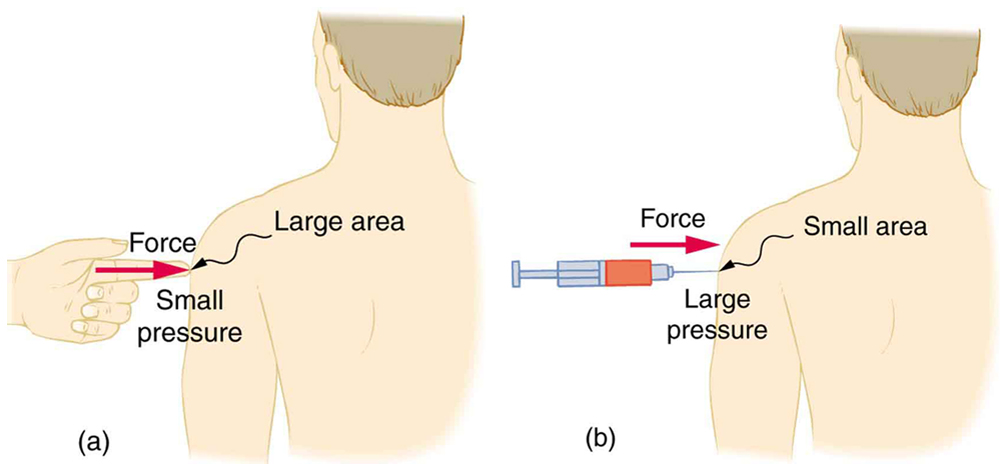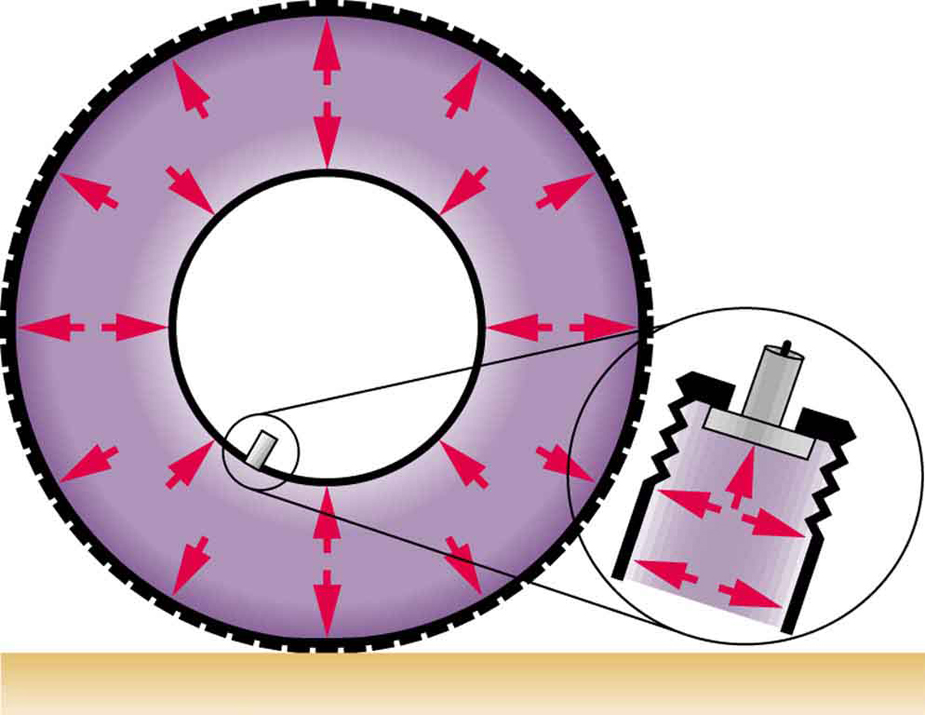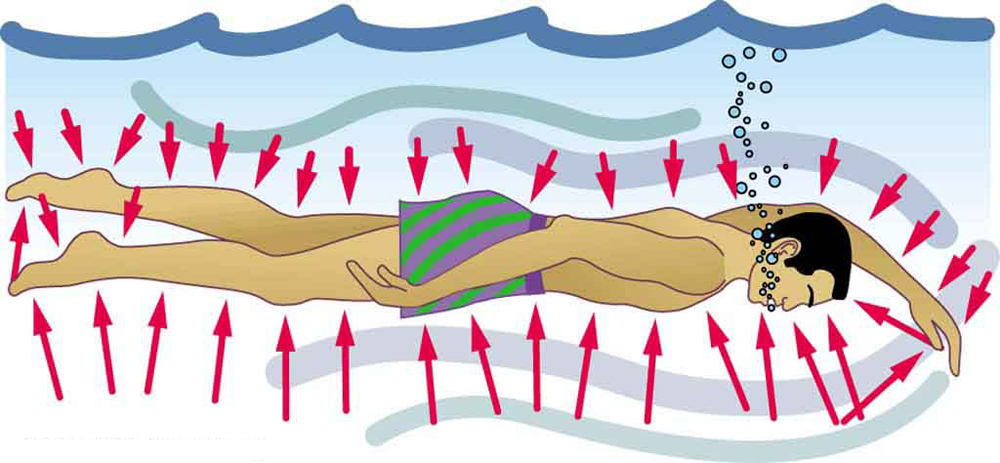Fluid Statics
77 Pressure
Learning Objectives
- Define pressure.
- Explain the relationship between pressure and force.
- Calculate force given pressure and area.
You’ve likely encountered the concept of pressure in multiple contexts—for example, in discussions of blood pressure or atmospheric pressure. Pressure plays a vital role in physiology, medicine, and meteorology, among other fields. In physics, pressure is defined as the amount of force applied per unit area:
Here, [latex]F[/latex] is the magnitude of the applied force, and [latex]A[/latex] is the area over which the force is distributed, perpendicular to the surface.
Pressure
Pressure is a scalar quantity that expresses how concentrated a force is when applied to a surface. Mathematically:
The same force can have very different effects depending on the contact area. For example, a gentle push with a finger spreads over a broad area, producing low pressure. In contrast, a needle tip applies the same force over a tiny area, creating high pressure that can pierce skin (see Figure 77.1).
The SI unit of pressure is the pascal (Pa):
Other common pressure units include:
- millibar (mb): used in meteorology; [latex]100~\text{mb} = 1 \times 10^5~\text{Pa}[/latex]
- pounds per square inch (psi): used in tire pressure and engineering
- millimeters of mercury (mm Hg): used in measuring blood pressure

Example 77.1: Calculating Force Exerted by Air
Problem: An astronaut is working outside the International Space Station, where atmospheric pressure is essentially zero. The pressure gauge on her air tank reads [latex]6.90 \times 10^6~\text{Pa}[/latex]. What force does this pressure exert on the flat end of the cylindrical tank, which is a disk 0.150 m in diameter?
Strategy
Use the formula [latex]F = PA[/latex] where area [latex]A = \pi r^2[/latex].
Solution
Discussion
This force is extremely large—over 122,000 newtons! That’s why pressurized tanks must be engineered to withstand such forces. The result also shows that pressure’s effect depends both on its magnitude and the area over which it acts.
Importantly, the force due to pressure in a fluid is always exerted perpendicular to the surface. This is because fluids cannot resist shearing (sideways) forces, so they can’t exert them either. Though pressure is a scalar, the forces it generates have well-defined directions—always perpendicular to surfaces (see Figure 77.2).

Similarly, in a swimming pool, pressure from the water acts on a swimmer’s body from all directions (see Figure 77.3). The deeper the swimmer, the greater the pressure exerted from below, contributing to buoyancy.

Section Summary
- Pressure is the force per unit perpendicular area over which the force is applied:
[latex]P = \frac{F}{A}[/latex]
- The SI unit of pressure is the pascal: [latex]1~\text{Pa} = 1~\text{N/m}^2[/latex].
- Fluids exert pressure equally in all directions, always perpendicular to the surface they contact.
Conceptual Questions
- How is pressure related to the sharpness of a knife and its ability to cut?
- Why does a dull hypodermic needle hurt more than a sharp one?
- The outward force on one end of an air tank was calculated in Example 77.1. How is this force balanced? (The tank does not accelerate, so the force must be balanced.)
- Why is force exerted by static fluids always perpendicular to a surface?
- In a remote location near the North Pole, an iceberg floats in a lake. Next to the lake (assume it is not frozen) sits a comparably sized glacier sitting on land. If both chunks of ice should melt due to rising global temperatures (and the melted ice all goes into the lake), which ice chunk would give the greatest increase in the level of the lake water, if any?
- How do jogging on soft ground and wearing padded shoes reduce the pressures to which the feet and legs are subjected?
- Toe dancing (as in ballet) is much harder on toes than normal dancing or walking. Explain in terms of pressure.
- How do you convert pressure units like millimeters of mercury, centimeters of water, and inches of mercury into units like newtons per meter squared without resorting to a table of pressure conversion factors?
Problems & Exercises
- As a woman walks, her entire weight is momentarily placed on one heel of her high-heeled shoes. Calculate the pressure exerted on the floor by the heel if it has an area of [latex]1\text{.}\text{50}\phantom{\rule{0.25em}{0ex}}{\text{cm}}^{2}[/latex] and the woman’s mass is 55.0 kg. Express the pressure in Pa. (In the early days of commercial flight, women were not allowed to wear high-heeled shoes because aircraft floors were too thin to withstand such large pressures.)
- The pressure exerted by a phonograph needle on a record is surprisingly large. If the equivalent of 1.00 g is supported by a needle, the tip of which is a circle 0.200 mm in radius, what pressure is exerted on the record in [latex]{\text{N/m}}^{2}[/latex]?
- Nail tips exert tremendous pressures when they are hit by hammers because they exert a large force over a small area. What force must be exerted on a nail with a circular tip of 1.00 mm diameter to create a pressure of [latex]3\text{.}\text{00}×{\text{10}}^{9}\phantom{\rule{0.25em}{0ex}}{\text{N/m}}^{2}?[/latex](This high pressure is possible because the hammer striking the nail is brought to rest in such a short distance.)
Glossary
- pressure
- the force per unit area perpendicular to the force, over which the force acts
the force per unit area perpendicular to the force, over which the force acts

